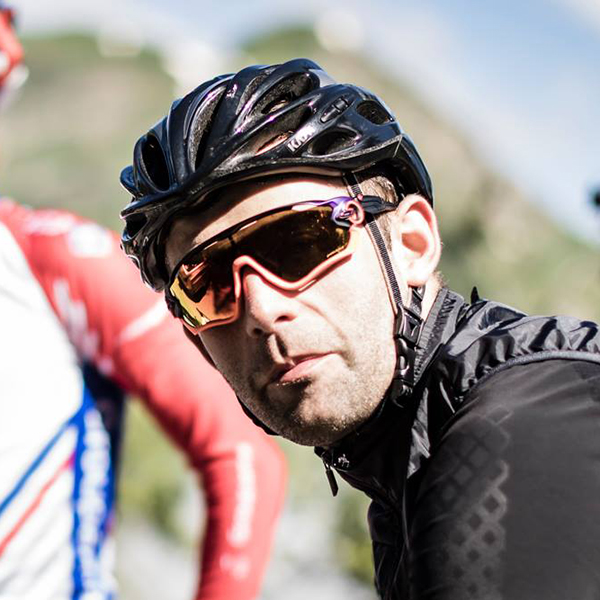Lauf has launched the Úthald, its first road bike, aiming to challenge established handling norms for the genre.
The Úthald, which means ‘endurance’ in Icelandic, follows the brand’s guiding principle that comfort equals a faster ride.
The bike has a geometry said to promote stable handling.
And although the Úthald frameset is said to offer a race-bike style fit and aerodynamic optimisations, it features a standard, non-integrated bar-stem setup for easier front-end adjustments.
There are two builds of the Úthald – named ‘Weekend Warrior Wireless’ and ‘Race Wireless’ – available for pre-order now, shipping in January 2024.
Prices start from $3,490 for the SRAM Rival eTap AXS-equipped ‘Weekend Warrior Wireless’ build and rise to $4,690 for the SRAM Force AXS ‘Race Wireless’ build.
An ‘Ultimate’ specification is set to follow in 2024.
Ashley Quinlan has ridden the new Lauf Úthald Race Wireless and you can read his first-ride review here.
Stability leads to speed
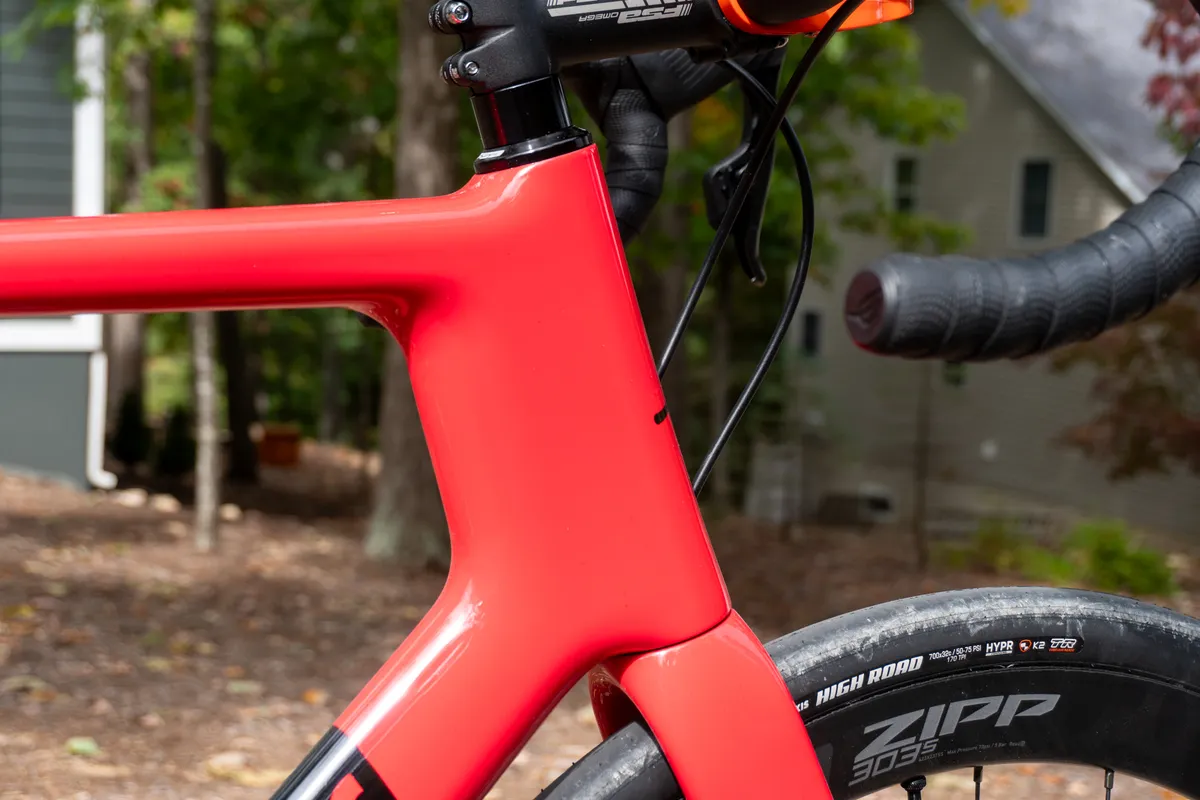
The Lauf Úthald is claimed to upset the apple cart, chiefly challenging the idea that faster handling translates to a faster road bike.
As such, it features a relatively slack 71.5-degree head angle across the size range, whereas typical race bikes are in the region of 72.5 degrees or steeper.
Lauf says it built a ‘variable head angle prototype’ bike, on which its test riders rode in various configurations until it arrived at the chosen angle, deemed to deliver the optimum handling characteristics.
The fork rake is 48mm – only slightly more compact than a 2024 Giant Defy (a relatively racy endurance road bike) at 50mm. Combined with the Úthald's slack head angle, though, the trail is much longer at 64mm in every size (the Defy’s trail sits at 58.6mm in all but the smallest size).
In general, a longer trail makes for a slower steering response and more stable handling.
| Frame size | XS | S | M | L | XL |
|---|---|---|---|---|---|
| Rider height (cm) | 156-165 | 166-174 | 175-182 | 183-190 | 191-200 |
| Frame reach (mm) | 373 | 378 | 389 | 400 | 411 |
| Frame stack (mm) | 514 | 537 | 564 | 593 | 623 |
| Head angle (degrees) | 71.5 | 71.5 | 71.5 | 71.5 | 71.5 |
| Stem length (mm) | 70 | 80 | 90 | 100 | 110 |
| Reach to handlebar (mm) | 426 | 440 | 461 | 482 | 503 |
| Stack to handlebar (mm) | 555-599 | 581-627 | 610-658 | 641-692 | 673-726 |
| BB to saddle top (mm) | 572-695 | 609-747 | 636-814 | 665-883 | 691-909 |
| Seat tube angle (degrees) | 73 | 72.8 | 72.6 | 72.5 | 72.4 |
| Seat tube length (mm) | 492 | 529 | 556 | 585 | 611 |
| Chainstay length (mm) | 405 | 405 | 405 | 405 | 405 |
| BB drop (mm) | 73 | 73 | 73 | 73 | 73 |
| Head tube length (mm) | 105 | 130 | 158 | 189 | 220 |
| Wheelbase (mm) | 970 | 983 | 1003 | 1023 | 1044 |
| Front Center (horizontal) (mm) | 572 | 585 | 605 | 625 | 646 |
| Axle to crown (mm) | 377.4 | 377.4 | 377.4 | 377.4 | 377.4 |
| Fork rake (mm) | 48 | 48 | 48 | 48 | 48 |
| Trail (mm) | 64 | 64 | 64 | 64 | 64 |
| Standover height (mm) | 720 | 753 | 779 | 808 | 835 |
Lauf’s CEO, Benedikt Skúlason, says learnings were taken from the development of the brand’s original True Grit gravel bike, where he observed that steeper head angles and shorter trails generally produced more nervous handling, which “held riders back”.
Applied in a road bike context, Skúlason and his design team suggest that the relatively sharp handling common across many race road bikes might make them feel faster, but doesn’t necessarily translate into real-world speed.
Instead, the Úthald’s slack front end is said to enable you to ride faster by handling more confidently and predictably, and, in turn, apply power more effectively.
However, unlike a typical endurance road bike, which features a relatively tall stack compared to a race-oriented bike, the Úthald is claimed to retain a “faster-fit”.
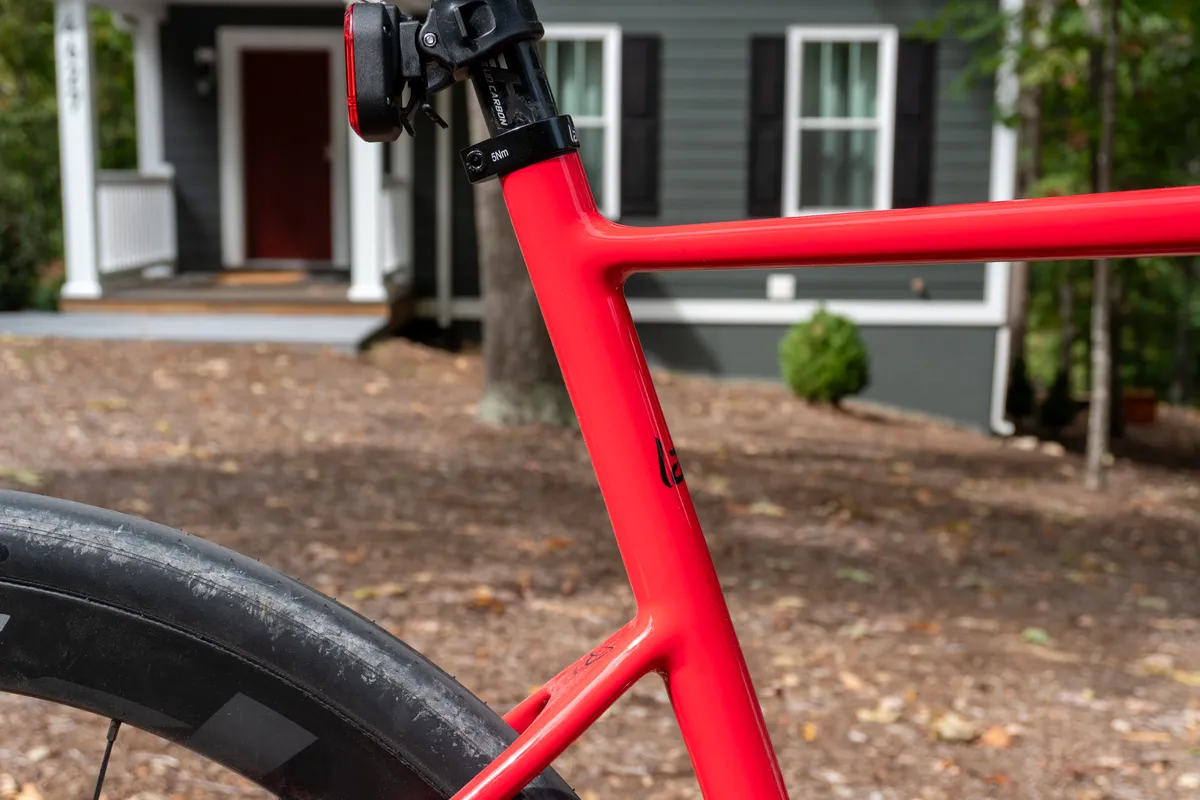
This is suggested to help the rider adopt a more aerodynamic position, while benefiting from the stable handling.
The seat angle is more traditional, at 72.5 degrees in a size Large, with the aim of pitching the rider further forward over the bottom bracket. In theory, this opens the hip angle for improved power transfer compared to a slacker angle.
Meanwhile, although the overall handling is said to be relatively easy-going compared to other race bikes, Lauf has opted to use compact 405mm chainstays. This is the minimum length officially supported by SRAM, the sole supplier of drivetrains for the Úthald.
In theory, this should elicit sharp responses from the rear of the bike when putting the power down.
Seigla-inspired compliance

Lauf claims most brands designing race and endurance bikes either don’t offer enough comfort for their riders’ needs, or unnecessarily (and expensively) over-complicate their approach to adding compliance.
The Icelandic brand says it has taken cues from its Seigla gravel bike, which pioneered this ICE (Integrated Compliance Engineering) approach to frame compliance, managing to engineer “around 15mm” of vertical flex into the Úthald’s Impact Resistant Modulus (IRM) carbon frame and components.
Four elements are said to combine to make this a reality: the slim junction of top tube and seat tube, the slim seatstay profile, the dropped seatstay and seat tube junction, and the offset seat tube design – plus the exposed portion of the seatpost.
This 15mm figure assumes a 75kg rider aboard, impacting a pothole, while already producing approximately 4.5mm of sag towards the rear hub.

Lauf says this level of compliance is similar to the amount seen from the pivot-based system used by a competitor it didn’t want to name (perhaps Cannondale and its Topstone Carbon).
This is in addition to the compliance afforded by the tyres – Lauf specs 700x32c tyres as standard on the Úthald, with the frame capable of accepting up to 700x35c rubber. Lauf says this “is in the ballpark” of what a 20-23mm wide road bike tyre can offer on its own.
Set against four “carbon road race bikes” from “major brands”, Lauf says the Úthald delivers at least 80 per cent more compliance through the saddle, and at least 25 per cent more compliance through the front end.
Aero… but no integrated cockpit
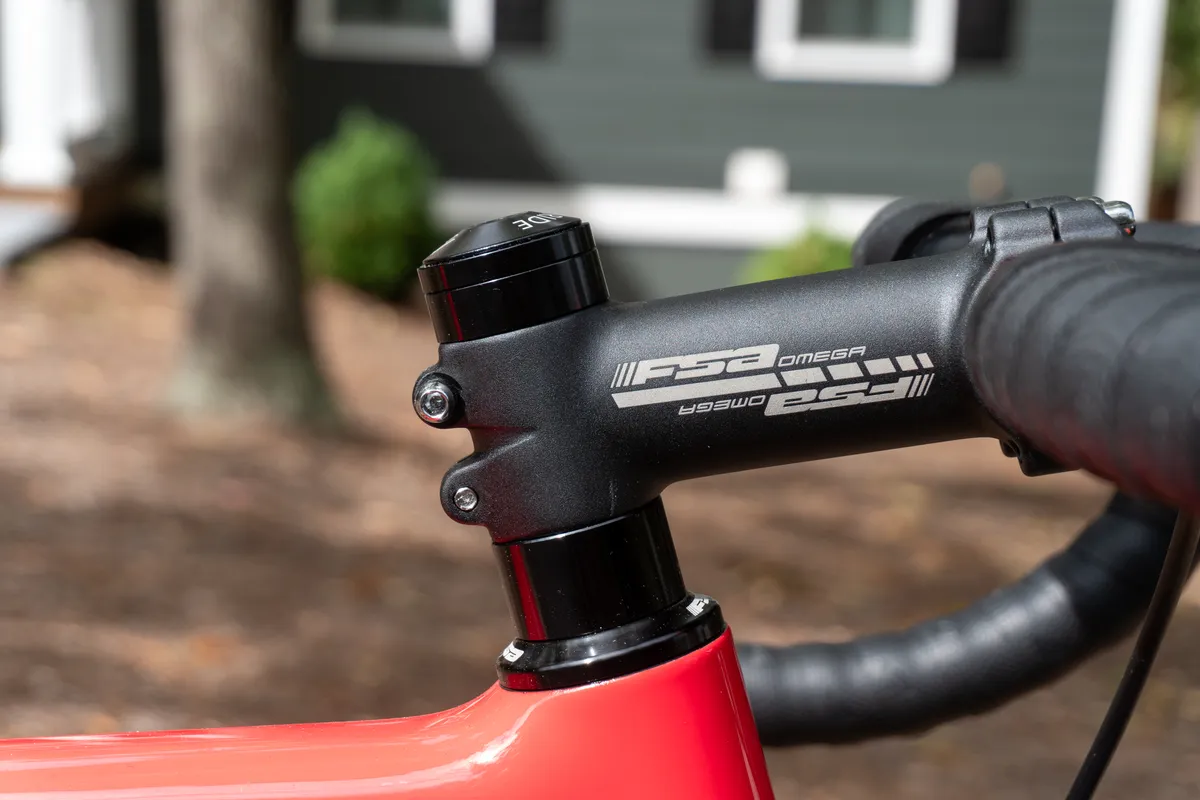
While most new road racing bikes are becoming ever more integrated at the front end, Lauf has opted for an old-fashioned, externally routed two-piece arrangement.
The brand uses its Smoothie road bar (attached to a standard stem), which incorporates glass-fibre sections on the tops, from the stem clamping zone to the ramps.
This is claimed to help improve compliance through the handlebar, while Skúlason says exposed brake hoses (which route internally from fork and down tube ports) in this area don’t cause any noticeable aero downside.

Lauf says it considered the use of full internal routing for the Úthald, exploring whether the benefits outweigh the drawbacks. Its conclusions were that:
- It doesn’t give the aero benefit often touted by brands
- It’s more difficult to work on, driving higher costs in time and/or labour
- It makes fit adjustments, which could bring aerodynamic or comfort benefits, harder to apply
- It makes travelling with your bike harder
Lauf also claims it has “yet to see a study that shows any non-negligible speed advantage to fully internal cable routing on a road bike”, suggesting any benefit is “extremely marginal”.
According to Canyon, the difference between the fully internal cable routing on its 2021 Aeroad and the external routing of the previous model is “up to 3 watts in extreme cases”.
Perhaps Lauf is right, then, though it’s also worth noting that while some riders feel internal cable routing has gone too far, it's possible many others simply like the way it looks, practicality be damned.

Cable routing aside, the Úthald is claimed to take advantage of lower-hanging fruit when it comes to aerodynamic design, focusing most of its attention on the leading edges of the bike.
The head tube and upper section of the down tube feature slim and deep profiles, with a backwards taper to form a teardrop-like trailing edge.
This, Lauf claims, keeps clean (laminar) airflow attached to the bike for longer, creating a smaller drag-inducing wake behind each tube.
It also says extending the head tube backwards, rather than forwards (as demonstrated most recently by Specialized’s ‘Speed Sniffer’ approach applied to the S-Works Tarmac SL8) helps to reinforce the junction of top tube and down tube for greater stiffness.
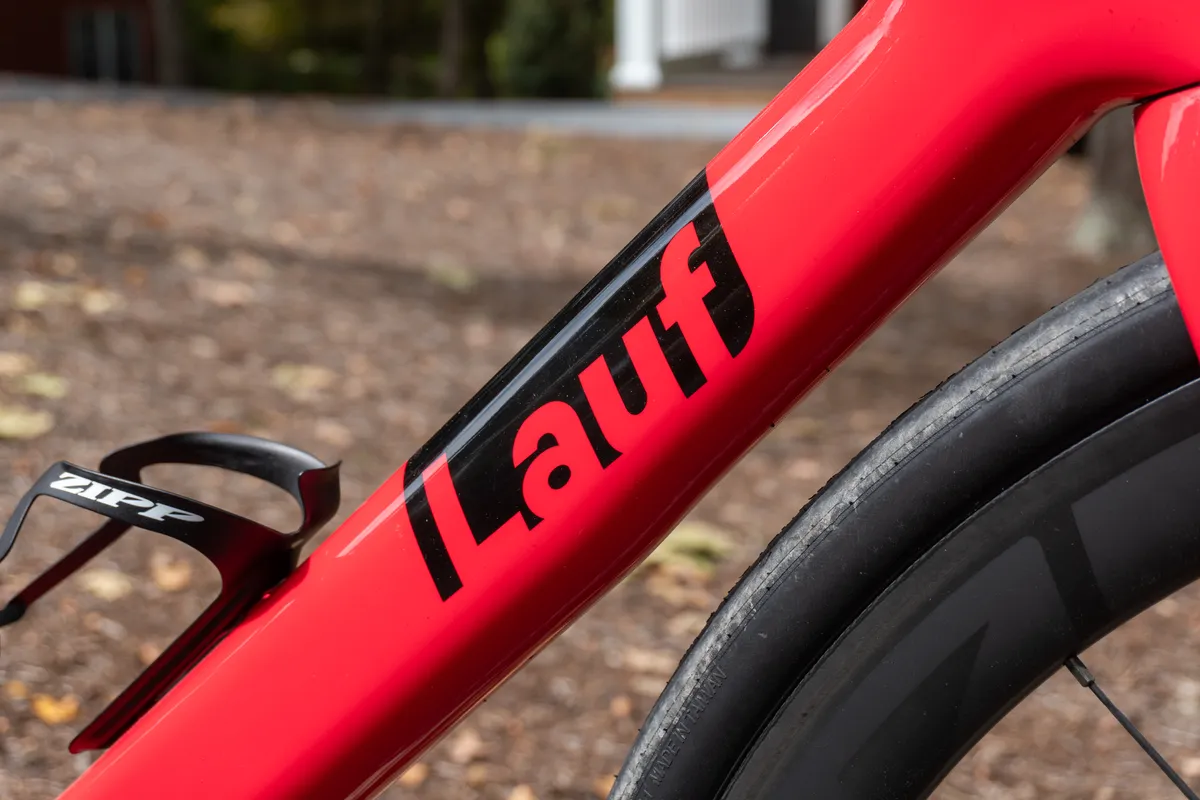
The fork legs have been designed with a bladed, aerodynamic profile. Lauf hints the profile chosen offers an optimal balance between aero performance, weight and strength.
The down tube ‘boxes out’ at the midway point, which is said to confer some shelter for water bottles (Lauf doesn’t quantify the aerodynamic benefit this brings, but it’s a feature typical of many of the best aero road bikes). It's also claimed to fortify the bottom bracket area for improved pedalling stiffness (the frame features a threaded BSA bottom bracket standard).
Lauf says the rear elements of the bike are less important for aerodynamics, but the slim seatstays – as well as contributing to the frame’s compliance – are dropped as far as UCI regulations allow for further aero gain (again, Lauf hasn’t quantified the gain this offers, but dropped seatstays are near-ubiquitous on aero road bikes for this reason).
It’s worth noting none of the above claims about the Úthald’s aerodynamic efficiency come with any data (such as that derived from wind tunnel or real-world testing) to back them up, though.
Lauf Úthald availability, pricing and specifications
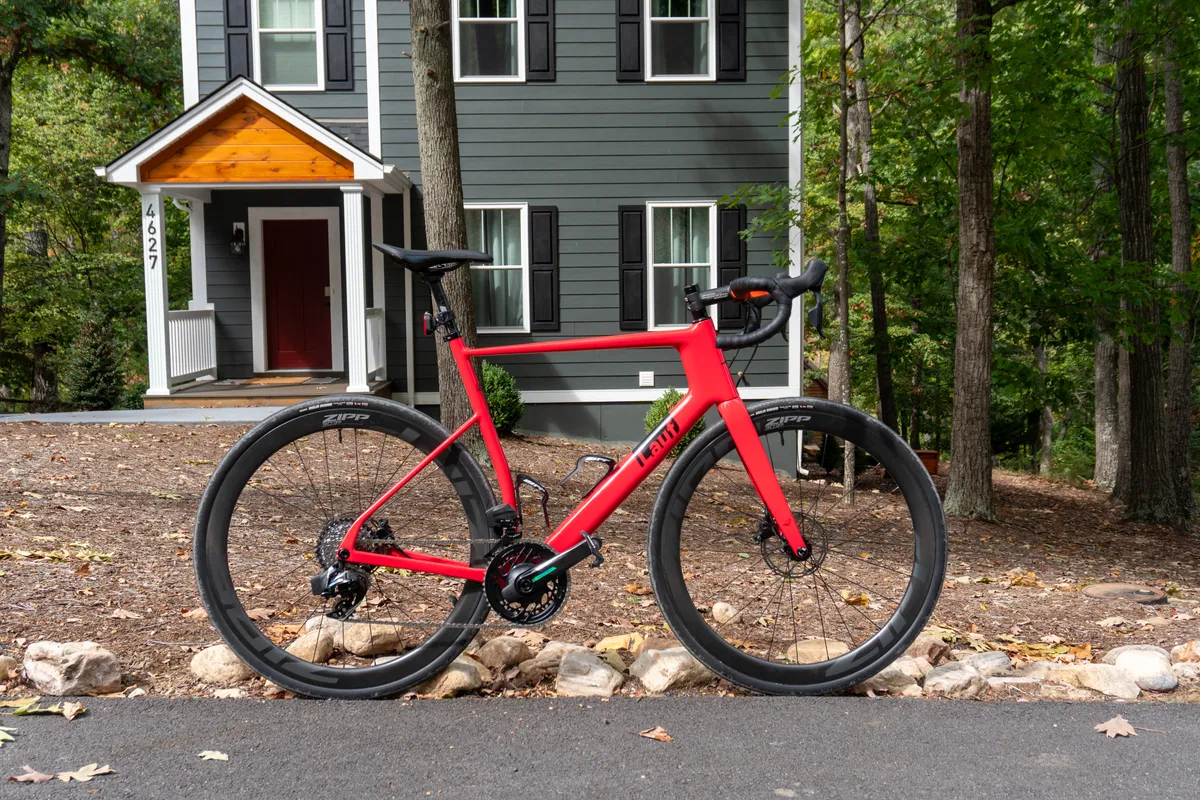
The Lauf Úthald is available globally for pre-order now, with first deliveries set to arrive in January 2024, according to the brand.
There are two builds at launch: the entry-level ‘Weekend Warrior Wireless’ with a SRAM Rival eTap AXS groupset and DT Swiss E1800 Spline alloy wheelset ($3,490, including a single-sided, left-only power meter), and mid-level ‘Race Wireless’ bike with a SRAM Force AXS groupset and Zipp 303S carbon wheels ($4,690, including a spider-based power meter).
The range will be topped by an ‘Ultimate’ model in summer 2024, which Lauf says will be available for around $7,500.
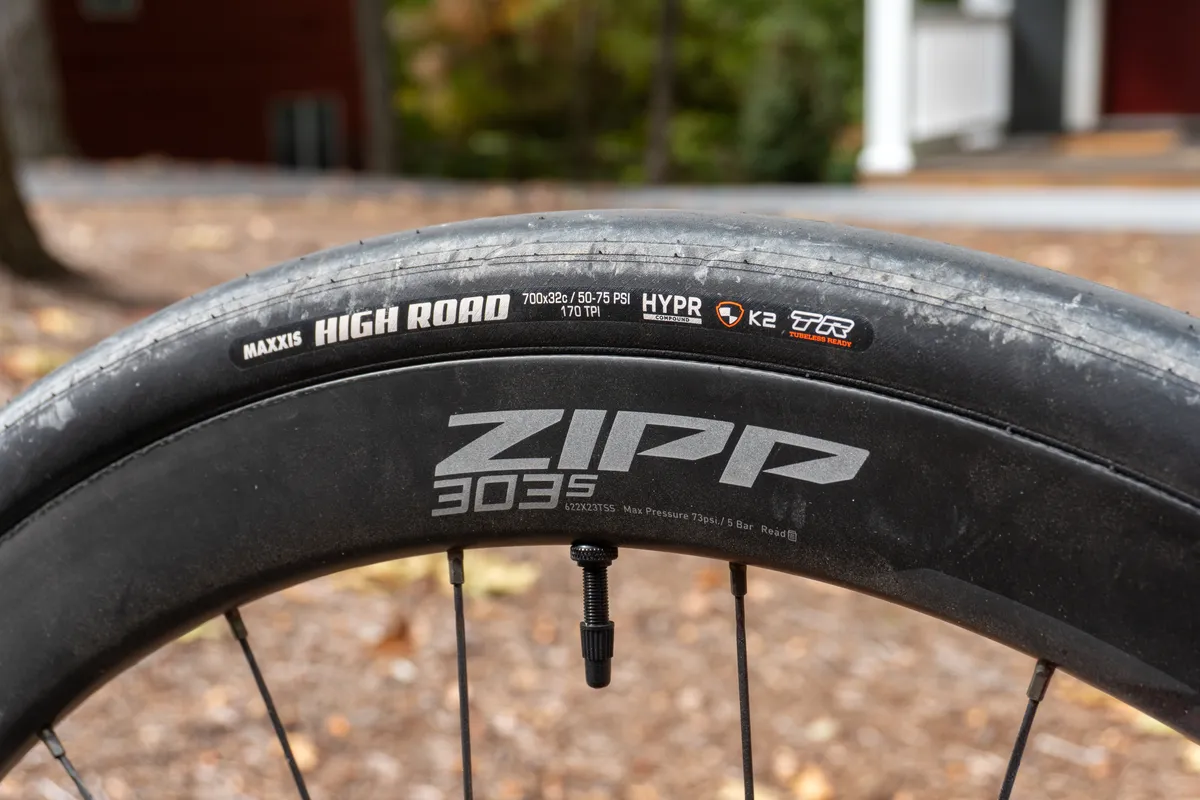
The Úthald is available in four colours: Obsidian Black (as standard), Rubus Red ($190 extra), and Borealis and Thingvellir Skye (both $390 extra).
Delivery costs $99 worldwide, exclusive of any tax and/or VAT.
Lauf Úthald Race Wireless
- Price: $4,690 (local currency subject to exchange rate)
- Frame: Lauf Úthald, IRM carbon
- Fork: Lauf Úthald, IRM carbon
- Groupset: SRAM Force AXS
- Power meter: Yes, spider-based
- Wheels: Zipp 303S, carbon
- Handlebar: Lauf Road Smoothie, glass fibre/carbon
- Stem: FSA Omega Pro, alloy
- Seatpost: FSA SL:K, carbon, 27.2mm
- Tyres: Maxxis High-Road, 700x32c, tubeless-ready
Lauf Úthald Race Wireless
- Price: $3,490 (local currency subject to exchange rate)
- Frame: Lauf Úthald, IRM carbon
- Fork: Lauf Úthald, IRM carbon
- Groupset: SRAM Rival eTap AXS
- Power meter: Yes, single-sided
- Wheels: DT Swiss E1800 Spline, alloy
- Handlebar: Lauf Road Smoothie, glass fibre/carbon
- Stem: FSA Omega Pro, alloy
- Seatpost: FSA SL:K, carbon, 27.2mm
- Tyres: Maxxis High-Road, 700x32c, tubeless-ready
